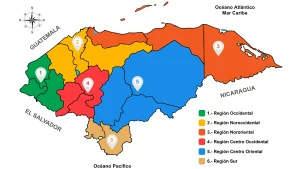Municipality of Meambar
Meámbar is a municipality in the department of Comayagua in Honduras.
The origin of the name given to the municipality, Meámbar, means «water of the cornstalks and sugarcane flowers» in Mesoamerican language.
The history of this municipality dates back to the times of the small indigenous village of Meámbar. It was entrusted to Alonso Contreras Oseguera and was founded in 1801. The indigenous settlement of Meámbar was located to the east of its current location on a promontory on the right bank of the Piojo River, where archaeological remains and mounds covered by vegetation can still be found.
It is worth noting that the original indigenous population settled in this area around 1630, but in 1801 Alonso Oseguera de Contreras decided to establish a town on the west bank of the Piojo River, which was elevated to the status of municipality in the same year.
The municipality of Meámbar is famous for having the most melodious bells in the country, and the material for their manufacture was extracted from a small deposit located west of the town in a place called Quebrada La Mina.
During the colonial period, Meámbar was located in a strategic geographic point, as it was in the center of the country and served as a rest stop for people traveling between the capital, Comayagua, and the Atlantic port area. It was an important commercial hub along the route between the Central Zone and the Northern Zone.
According to some municipal records, this route was frequently used during the campaigns of General Francisco Morazán Quezada.
Today, the route still exists but is in a state of deterioration and neglect, much like the rest of the municipality. It is only used as a passable secondary road during dry seasons since the main highway shifted 30 kilometers southwest and now passes through the city of Siguatepeque, which has taken the place that Meámbar once occupied.
About four miles northwest of the municipality, on the Maragua River between the villages of Potrerillos and Loma Alta, there is a petrified forest. Additionally, a little further north in a place known as La Tejera, between the villages of Loma Alta and Palmital, there are caves containing archaeological remains and petroglyphs from pre-Columbian populations belonging to the Lenca culture.
Location
The municipality is located in the northwest of the Comayagua department, 30 kilometers northeast of the city of Siguatepeque. It borders Cortés department to the north and west. It is traversed by the Maragua River, and to the west of the center is the Laguna Seca Mountain.
Among its main geographical features are the Francisco Morazán Hydroelectric Dam (commonly known as El Cajón), which occupies a large part of the northeastern territory and whose dam and machinery are located in the municipality of Santa Cruz de Yojoa, in the department of Cortés. Additionally, the Meámbar Azul National Park is located to the west of the municipality and borders Lake Yojoa to the west.
Natural Resources
The municipality’s territory is predominantly covered by broadleaf forests, accounting for approximately 80% of the area. The flora includes species such as Pinus ocarpa, Pinus Caribea, oak, encino, curtidor, quebracho, guanacaste, ceiba, mahogany, fig tree, laurel, and liquidambar, among others.
Agriculture and Livestock
The main agricultural products include basic grains, sugarcane, cucumber, coffee, beet, and annatto.
The primary livestock in the municipality consists of cattle, horses, pigs, and poultry. Poultry farming is also a fundamental pillar of the municipal economy.
Localities
Meámbar has exactly 17 villages and 93 hamlets as of 2009. The municipal seat, Meámbar, is located in the south-central part of the municipality on the west bank of the Piojo River, a tributary of the Maragua River.
- The Patron Saint Fair is celebrated on August 15 in honor of the patron saint, Saint Benedict.



